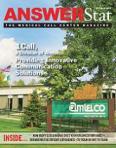By Kevin Beale
I think it’s human nature to find things to keep ourselves busy. I certainly am no exception to that rule. I always have a million things I need to be doing for work or at home. One of the hardest things to do is to take a step back from our daily regimen to plan for the future.
Occasionally, looking into the future is a good exercise. So here goes.
Predicting the future of a business segment such as call centers is not magic, it is simply a process of paying attention to trends and making calculated guesses on how those trends will continue or change in the future.
One of the constants of our industry is change. We are constantly being pushed by clients to offer enhanced services to meet their unique business objectives. Clients don’t care about the technology utilized to run our call centers as long as they feel we’ll be there when they need us. They’re focused more on the services we provide for them. That’s where each call center has the opportunity to distinguish itself from the competition.
Call scripting
Call centers have always guided agents through call flows. In the past, this was done by reading instructions and forcing our agents to make on-the-fly decisions. The new model for call flow guidance tends more to sophisticated scripting engines. Scripting shifts the burden of making decisions away from the frontline agents and puts it in the hands of supervisors and managers who can work with clients to determine and agree on the optimum call flow. The role of scripting will continue to expand and grow to include scripting of the dispatch process and Web-connectivity to client systems.
Virtualization
Virtual call centers will become more prevalent in the coming years, especially as an element of the consolidation that is taking place in the call center industry. Virtual call centers will be much more flexible than traditional call centers which are constrained by their locations, floor space, and physical agent positions. Virtual call centers will utilize collocated call center solutions and remote agents. Use of a collocated call center solution breaks the call center away from the physical constraints and overhead costs of a building, equipment room, and back-up power. The use of remote agents eliminates physical floor space requirements, heating and cooling, break rooms, agent computers, and, more importantly, allows much more flexible hour-by-hour staffing, greatly minimizing the biggest non-essential expense a call center faces, the overhead of idle labor.
Shared services
Many call centers are forming partnerships with other call centers with the goal of sharing client calls to form one large borderless call center. Sharing client calls can greatly expand the call volume capacity of participating call centers, allowing each call center to market to larger clients with the assurance they will have the capacity to meet the client’s traffic requirements. There are two aspects to client sharing: redirecting or overflowing of calls, which can be accomplished through arrangements with telephone carriers and can be enhanced through use of VoIP-based SIP trunking, and the sharing of client scripts and data. The use of Web scripting and client sharing tools, such as those available with AMTELCO’s Intelligent Series, can assist call centers in implementing this business expansion strategy.
Call forwarding
One-number call forwarding has been gaining popularity for several years. This trend will continue and will pick up steam in the years ahead. The driving factor for this shift is cost savings, both in terms of telephone carrier costs and potential tax savings if proposed surcharges (new taxes) on phone numbers are enacted. One-number call forwarding allows call centers to eliminate the vast majority of DID numbers by keying on the calling number, called number or forwarded number of each call. Call center systems that can read any of these call fields on a client-by-client basis, provide big benefits to their owners.
Disaster planning
Disaster recovery has become a major focus of the call center industry across all vertical markets. This trend will continue. Disaster recovery solutions may be put in place by call centers within their infrastructure to provide redundancy of essential call center components. It may also be implemented by partnering with their vendor on hosted disaster recovery solutions. A recent example of the power of partnering with a call center vendor for disaster recovery is the situation that occurred at a Midwest call center that lost all telephone connectivity for several days when a major cable was cut by a construction crew. The call center worked with its phone carrier to quickly redirect calls to an emergency backup system at AMTELCO’s corporate headquarters in McFarland, Wisconsin. This kept the call center in business during a situation that stretched into days and could have been catastrophic. Every call center should be making such disaster recovery plans.
VoIP technology
Voice over Internet Protocol (VoIP) will continue to become more prevalent in the call center industry. The growth of VoIP will benefit call centers looking to expand on their use of remote agents, by providing low-cost audio connectivity that is available virtually anywhere. Over the next few years, we’ll start to see VoIP take hold on the trunking side of the business. Call centers will begin replacing their existing PRI ISDN spans with VoIP-based SIP trunks and will find them to be cost effective and reliable. SIP trunks provide many benefits to call centers, including cost savings, nationwide local numbers, and more flexibility in overflowing calls to partner call centers and rerouting calls for disaster recovery situations.
Soft Switching
There is an emerging trend towards software-based switching in the telecom industry. Software-based switching utilizes a computer’s central processor to manage switching functions rather than CTI board-based processors and DSP resources. One of the challenges of software-based switching has been to match the scalability and reliability of hardware-based switching. This is still a work in progress with open-source PBX’s such as Asterisk leading the way. While we may not see mainstream call centers banking their entire business on soft switching for quite some time, we will see call centers utilizing soft switching for specialized functions and applications. These software-based switching solutions will continue to advance and become more prevalent in the call center industry.
Soft Agents
One soft switch-related opportunity for our industry will be the emergence of switch independent soft agents, such as AMTELCO’s Infinity Soft Agent, that are capable of integrating with any third-party PBX or ACD system. This will give call center owners much more flexibility in selecting their switching platforms and will open up the opportunity to connect directly to client PBX’s and ACD’s.
Change is inevitable and not to be feared. It’s one of the exciting things about the call center industry. We are constantly forced to reshape our businesses to meet ever changing client demands. I guess that’s why we like what we do so much.
(Kevin Beale is director of software research and development for AMTELCO and 1Call)

WordPress Tags: Call center,Kevin,Beale,call center industry,VoIP technology,Call guidance,client,Virtualization,Virtual Agent,Call,agent,solution,equipment,expense,goal,assurance,traffic,arrangements,VoIP,data,tools,AMTELCO,Intelligent Series,expansion,strategy,trend,factor,cost,savings,carrier,taxes,numbers,basis,benefits,Disaster,recovery,infrastructure,redundancy,components,vendor,example,situation,Midwest,cable,construction,emergency,backup,call center system,headquarters,McFarland,Wisconsin,plans,Voice,Internet,Protocol,growth,ISDN,trunks,Soft Switch,Software,computer,processor,Asterisk,emergence,Change,demands,development,trends,agents,decisions,supervisors,managers,systems,locations,solutions,computers,Telecommunications carriers,Call scripts,call center platforms
![]()








